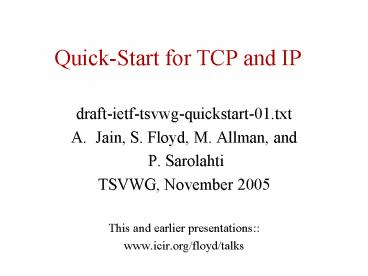Quick-Start for TCP and IP - PowerPoint PPT Presentation
Title:
Quick-Start for TCP and IP
Description:
Routers on the path decrement a TTL counter, and decrease the allowed sending ... the IP TTL by more than once, to emulate the hopcount of the underlying path. ... – PowerPoint PPT presentation
Number of Views:26
Avg rating:3.0/5.0
Title: Quick-Start for TCP and IP
1
Quick-Start for TCP and IP
- draft-ietf-tsvwg-quickstart-01.txt
- Jain, S. Floyd, M. Allman, and
- P. Sarolahti
- TSVWG, November 2005
- This and earlier presentations
- www.icir.org/floyd/talks
2
QuickStart with TCP, for setting the initial
window
- In an IP option in the SYN packet,
- the sender's desired sending rate
- Routers on the path decrement a TTL counter,
- and decrease the allowed sending rate, if
necessary. - The receiver sends feedback to the sender in the
SYN/ACK packet - The sender knows if all routers on the path
participated. - The sender has an RTT measurement.
- The sender can set the initial congestion window.
- The TCP sender continues using normal congestion
control.. - From an initial proposal by Amit Jain
3
Changes since last IETF
- Added a 30-bit QS Nonce (feedback from Guohan Lu
and Gorry Fairhurst). - Significantly revised the section on IP tunnels
and on IPsec AH (feedback from David Black and
Joe Touch) - Added a section about "Possible Uses for the
Reserved Fields". - General editing (feedback from Gorry Fairhurst
and Martin Duke).
4
To do
- Delete the sentence in Section 4.6.2 about a
retransmitted SYN packet using a different
Initial Sequence Number. - Respond to feedback from Bob Briscoe.
5
The 30-bit QS Nonce
- Initialized by sender to a random value.
- If router reduces Rate Request from K to K-1,
router resets related bits in QS Nonce to a new
random value. - Receiver reports QS Nonce back to sender.
- If Rate Request was not reduced in the network
below K, then the lower 2K bits should have their
original random value.
6
The 30-bit QS Nonce
- Bits Purpose
- --------- ------------------
- Bits 0-1 Rate 15 -gt Rate 14
- Bits 2-3 Rate 14 -gt Rate 13
- Bits 4-5 Rate 13 -gt Rate 12
- Bits 6-7 Rate 12 -gt Rate 11
- Bits 8-9 Rate 11 -gt Rate 10
- Bits 10-11 Rate 10 -gt Rate 9
- Bits 12-13 Rate 9 -gt Rate 8
- Bits 14-15 Rate 8 -gt Rate 7
- Bits 16-17 Rate 7 -gt Rate 6
- Bits 18-19 Rate 6 -gt Rate 5
- Bits 20-21 Rate 5 -gt Rate 4
- Bits 22-23 Rate 4 -gt Rate 3
- Bits 24-25 Rate 3 -gt Rate 2
- Bits 26-27 Rate 2 -gt Rate 1
- Bits 28-29 Rate 1 -gt Rate 0
7
IP Tunnels and Ipsec AH
- Quick-Start is compatible with IPsec AH. (The
Integrity Check Value covers the right things.) - There are some tunnels that are not compatible
with Quick-Start (Section 6.2) - This refers to tunnels where the IP TTL is not
decremented before encapsulation - Therefore, the TTL Diff is not changed
- The sender can falsely believe that the routers
in the tunnel approved the Quick-Start request. - This will limit the possible deployment scenarios
for Quick-Start.
8
Possible Uses for the Reserved Fields
- Reporting Approved Rate.
- Report of Current Sending Rate.
- Request to Increase Sending Rate.
- RTT Estimate.
- Informational Request.
- Use Format X for the Rate Request Field.
- Do Not Decrement.
9
From Feedback from Bob Briscoe
- Clarify Experimental status.
- Clarify router requirements for judging a link to
have been underutilized. - Add description of possible alternatives
- for QS nonce
- for an expanded range for the rate request
- for an alternate encoding for the rate request
- But dont change the current proposal.
10
From Feedback from Bob Briscoe
- Problems with untrusted senders
- Add Reporting Approved Rate?
- The Quick-Start Option in QS data packets would
report the approved rate request, along with the
QS Nonce returned with that rate request. - Add a standardized timeout for rate requests?
- Rate requests are only valid at the sender if the
response is received within N seconds? - Add error codes from routers to end nodes?
- Using one of the reserved bits, and the Rate
Request or QS Nonce field?
11
Slides from last time
12
Section 3.6 A Quick-Start Nonce?
- There are four unused bits in the IP option -
- Use them for a Quick-Start Nonce?
- Some times the receiver knows the original rate
request R. - Goal of QS Nonce discourage receivers from lying
about the value of the received rate request. - Mechanics
- Sender sets QS Nonce to a random value.
- When a router reduces the approved rate request,
it sets the QS Nonce to a new random value. - Receiver reports back value to sender.
- If no routers reduced the rate request, then the
QS Nonce should have its original value. - Should we add this to the spec?
13
Feedback from Joe Touch about IP tunnels
- Tunnels that arent part of the forwarding path
dont decrement the inner headers IP TTL. - The decrement is supposed to occur before
encapsulation. - IPsec tunnels need to be addressed they
typically drop IP options. - Some tunnels decrement the IP TTL by more than
once, to emulate the hopcount of the underlying
path.































